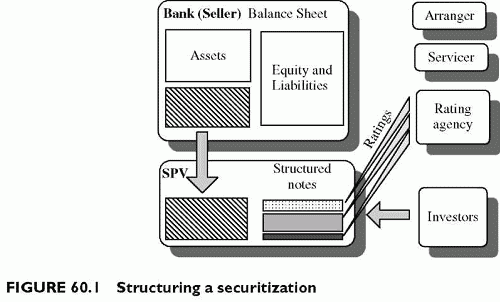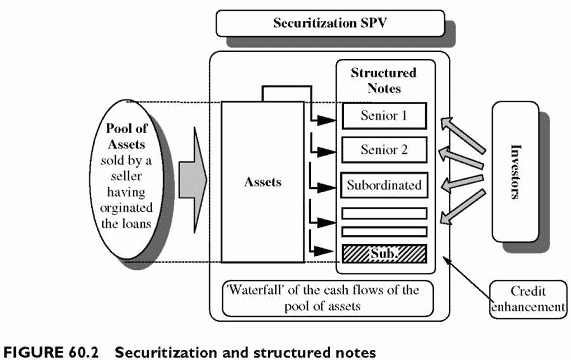SECURITIZATION MECHANISMS
Category: Risk Management in Banking
The rationale of securitizations is very simple. The first motivation is arbitraging the cost of funding in the market with funding on-balance sheet, for a bank or a corporate entity. The second motivation is off-loading credit risk to free capital for new operations or to modify the risk-return profile of the loan portfolio of banks.
Figure 60.1 summarizes the basic mechanism of a securitization. The seller of the assets is often a bank, or a corporate firm looking for attractive funding of account receivables. The SPV assets generate cash flows that serve to pay the note holders. The structured notes have different risk-return profiles, and different maturities. Rating agencies provide a rating for each class of structured note, and provide the necessary information to investors to make the notes tradable. The arranger structures the transaction. The servicer takes care of day-to-day operations during the life of the transaction.
The SPV isolates the pool of assets from the seller. The non-recourse sale implies that the seller is not responsible for losses by note holders. The SPV, or the fund, is a shield between lenders to the SPV and the seller of assets. The distinction between selling the assets and selling their risk only became practical with the development of synthetic structures in recent years. Sometimes, selling the assets is difficult because the authorization of borrowers is necessary. Selling the risk without selling the assets is feasible with credit derivatives such as credit-linked notes or similar, as detailed in
Chapter 58. The structuring of the transaction relies on covenants that rule the governance of the SPV during its life. It also refers to the structuring of the notes issued to investors: size, seniority level in terms of claims on SPV cash flows, customizing risk-return profiles so they fit the needs of investors. To customize the risk-return profile of the structured notes issued to fund the SPV, it is necessary to set up an insurance mechanism that differentiates their risks, makes them explicit and makes these notes marketable.
The Insurance Mechanism
The basic insurance mechanisms consist of differentiating the seniority levels of notes issued, so that some have a higher priority claim on the cash flows of the SPV, and others a subordinated claim. This differentiates the risks across notes, while simultaneously ensuring a protection for the more senior notes. The protection simply results from the fact that equity and subordinated notes provide first loss protection.
The pool of assets generates future flows of different types: interest, capital repayment and prepayment of existing loans. A fraction of these flows is uncertain since defaults, payment delays and prepayments can happen at any date. However, the grouping of the assets into large pools of transactions makes it feasible to capture such uncertainties through statistics.
The simple way to provide a safety cushion is to use an oversized pool of assets. Since only a fraction of the pool suffices to pay investors, they have a protection against adverse deviations of the flows generated by the pool because of this safety cushion. For instance, a pool of assets can generate 100, and only 90 is necessary to pay off low-risk investors. The risk of loss for these investors materializes when the actual flow goes under 90. The excess of 10 means that the structure pays the flows promised to investors as long as the flows generated by the assets do not decrease by more than 10%. In practice, there are several classes of structured notes ranked by seniority level.
Structured Notes
The structuring of the transaction consists of defining the amounts of the various notes issued and their risk-return profile. The main structuring factors are the seniority levels and the amounts of the notes. All notes subordinated to a given senior note absorb losses first. They act as a safety cushion, protecting the senior note. When cash flows do not suffice to pay all the obligations to all note holders, the deficiencies hit the subordinated notes first. At the lower end of subordination, the risk is maximal, since this range concentrates all the risk of the pool of assets. At the upper range of senior notes, the risk is quasi-zero because it is practically impossible for losses to reach a level such that they would hit this upper class of notes.
The subordination level of a note is the amount (as a percentage of total assets funded) of subordinated notes that protect the senior ones. The higher this safety cushion, the lower the risk of the notes protected by the subordinated notes. Agencies rate notes according to risk. The last subordinated note, which is like equity, gets all the first losses and has no rating. Senior notes can be investment grade, because the likelihood that the loss in pool of assets exceeds the safety cushion provided by the subordinated notes is near zero for the highest grades. When moving down the scale of seniority, the loss franchise provided by the subordinated notes shrinks. Either the seller of assets or a third party, acting as a credit enhancer for others, holds the last tranche. Since the equity tranche bears all the risk of the assets, the spread compensating credit enhancers is high.
The Waterfall of Cash Flows and Losses
The structure re-routes the flows generated by the pool of assets to investors using priority rules based on the seniority level of the structured notes, first to senior notes and last to the equity tranche. This is the waterfall of cash flows. The waterfall of losses follows a symmetrical path. First, they hit the credit enhancer, then the subordinated notes and only then the senior notes. The first cash flows go to the senior notes. The first losses go to the subordinated notes (Figure 60.2).
Customization of Structured Notes
Structuring through differentiated seniority levels allows the issuance of several types of securities differing in terms of their risk-return profile and maturity. Issuing several classes of structured notes of different seniority levels makes the securities attractive to various populations of investors, over the entire spectrum of risks. High-risk notes are of interest to investors looking for a higher expected spread in compensation for the added risk. Investors in senior notes benefit from a good rating, while having a return higher than with the same rating bonds, perhaps because the market values the risk differently for structured notes and plain bonds. Maturities vary across notes, under the sequential amortization scheme, because the payments flow first to senior notes, thereby amortizing them quicker. The concurrent amortization scheme requires amortizing notes in parallel. The seniority level of a structured note drives the required return, hence its cost.
Resiliency and Stress Testing Securitizations
The resiliency of a structure designates its ability to sustain large variations in risk drivers without generating losses to the various classes of structured notes. Critical parameters that determine the resiliency of structures depend on the type of structure. For consumers or mortgage loans, typical critical parameters include: the delinquency rate (delays in payment), the charge-off rate (losses due to default), the payment rate (both monthly payments of interest and principal), the recovery rate (both percentage amount and timing of recoveries) and the average yield of the portfolio of loans. For other structures such as CDOs, critical parameters include: the degree of over-collateralization, or the excess amount of asset value over note value, the diversification of the portfolio of assets and the interest rate risk.
Stress scenarios on critical parameters such as charge-offs and minimum amounts of collateral serve to assess the resiliency of the structure and the risk of the various classes of structured notes issued. A typical way to assess the resiliency of structures by rating agencies consists of stress testing all critical risk drivers, such as the ones above. The same stress tests serve for rating the notes, in addition to measuring the resiliency of the structure.
The first purpose is to check whether each class of structured note suffers from loss when stress testing the values of these risk drivers. A very common way of validating the risk of a structured note is to apply to the portfolio of assets a multiple of the expected charge-off rate and check that notes do not suffer from losses. For a given note, the higher the multiple of charge-offs sustainable by the note without any loss, the higher the rating. For instance, the required multiple for a triple AAA scenario is obviously higher than for a risky subordinated note. The terminology might be confusing. An AAA scenario designates the minimum required multiple to have an AAA rating, and is a highly stressed scenario, because it is the one required to assign the best rating. Typical stress tests apply a high multiple to charge-off rates, for example five or six times the expected average charge-off rate for senior notes.
One easy way to assign ratings to notes is to map these multiples with the note ratings. Evidently, the minimum multiple required to have a given rating also depends on the quality of the assets. Hence, the AAA scenario, or the AAA multiple of expected loss, is lower when the average risk of assets is medium or low than when the risk of assets is high (average rating low). This is a practical shortcut to full modelling of the risk of the portfolio of assets in CDOs, as detailed in the following two sections explaining the economics of securitizations for the seller of assets. The full assessment of the structured note ratings requires plugging these scenarios into the spreadsheet model of the waterfall of cash flows and redirecting the loss to the notes, allocating first losses to the lower seniority levels. The simulation tells us whether a loss occurs to notes other than the equity.


